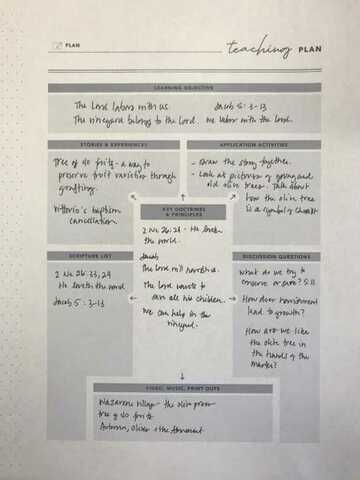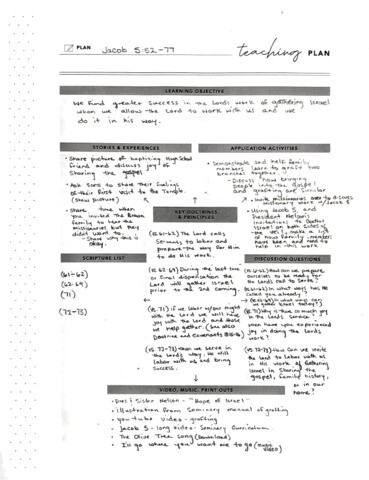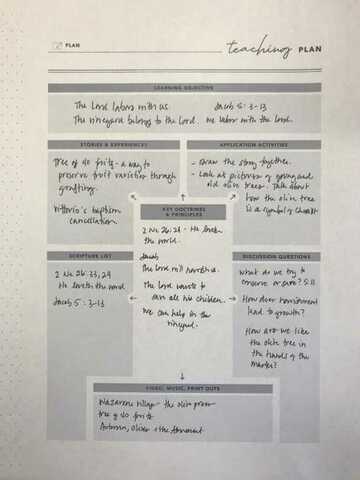The following article is brought to you by Gospel Day by Day, a community designed to help parents lead home-centered gospel learning. You can find Gospel Day by Day on Instagram here.
Need a way to organize your thoughts on how you’ll teach Jacob 5 to your family? Try using a teaching plan. A teaching plan is a way to keep track of what needs to be learned, how it will be taught, and how learning will be measured. In your home, a teaching plan can be used as a tool to help you organize your spiritual thoughts and turn them into meaningful and memorable gospel lessons and discussions.
Use thisfree teaching plan download and to help you get started. You’ll find an explanation of each section of the teaching plan below. We’ve also included two examples to illustrate how this works, each focusing on a different part of Jacob 5 and tailored to the needs of two individual families, that can help you think through your own teaching plan for Jacob 5 and beyond.


This teaching plan is divided into the following seven sections:
1. Learning Objective
This section helps to give an overall focus for the week, summarizing into one phrase or sentence the main idea you want to focus on teaching your family. It works best if it is centered on what you want family members to be able to do as a result of the daily study. (Sometimes it is easier to create a learning objective after you have filled out more of your teaching plan.)
Family #1’s Learning Objective: Jacob 5:3–13. The vineyard belongs to the Lord. We labor with the Lord, the Lord labors with us.
Family #2’s Learning Objective: Jacob 5:52–77. We find greater success in the Lord’s work of gathering Israel when we allow the Lord to work with us and we do it in His way.
2. Key Doctrines and Principles
This is the heart of the teaching plan because all other activities will flow from the key doctrines and principles. Write a brief summary of one or two truths from each chapter that you want your family to identify.
Family #1’s Key Doctrines and Principles (from Jacob 5:3–13):
- God loveth the world (2 Nephi 26:21).
- The Lord will nourish us (5:5).
- The Lord wants to save all His children (5:13).
- We can help in the vineyard (5:10).
Family #2’s Key Doctrines and Principles (from Jacob 5:52–77):
- The Lord calls servants to labor and prepare the way for Him to do His work (5:61–62).
- During the last time, or final dispensation, the Lord will gather Israel prior to the 2nd coming (5:62–64).
- If we labor with our might with the Lord, we will have joy with the Lord and those we help gather (5:71, Doctrine and Covenants 18:15–16).
- When we serve in the Lord’s way, He will labor with us and bring success (5:72–73).
3. Stories and Experiences
Think back on personal experiences you’ve had while living the key doctrine or principles you identified. Also, you might ask family members ahead of time to share an experience they’ve had living one of the doctrines or principles you’re discussing. List as many as you can think of and label them by the coinciding chapter.
Family #1’s Stories and Experiences (based on Jacob 5:3–14): Watch the “Tree of 40 Fruits” video. This is a way to preserve fruit varieties through grafting. Share the mission experience of when Vittorio canceled his baptism because of family threats.
Family #2’s Stories and Experiences (based on Jacob 5:52–77): Share picture of me baptizing my high school friend and discuss the joy of sharing the gospel. Ask my sons to share their feelings of their first visit to the temple (show picture). Share time when you invited the Brown family to hear the missionaries, but they didn’t want to and why this is okay.
4. Application Activities
Here’s where you can show how the scriptures apply to everyday life. Use cues from the chapters, such as keywords, lists, and the prophets’ personal stories to relate the scriptures back to everyday life. The ideas in the Come, Follow Me manual are a great resource. If those ideas don’t feel like a good fit for your family that week, think through how you might adapt them for your needs.
Family #1’s Application Activities (based on Jacob 5:3–14): Look at images of olive trees, then draw the olive tree in stages, including how they might look with decay. Talk about how the olive tree is a symbol of Christ.
Family #2’s Application Activities (based on Jacob 5:52–77): Demonstrate and help family members learn to graft two branches together, then discuss how bringing people into the gospel and grafting are similar. Invite our ward’s missionaries to discuss missionary work using Jacob 5. Reference Jacob 5 and President Nelson’s invitations to gather Israel on both sides of the veil and make a list of how many family members have been and need to help in this work.
5. Scripture List
Now that you have a general idea of some of the topics you want to focus on, make a list of scriptures that identify or explain the Key Doctrines and Principles you have picked from the chapters. Mark or highlight them in your scriptures.
Family #1’s Scripture List:
- Jacob 5:3–14
- 2 Nephi 26:24, 33
Family #2’s Scripture List:
- Jacob 5:61–62,
- Jacob 5: 62–64,
- Jacob 5: 72–73
6. Discussion Questions
When formulating questions to ask, think about what might help your family focus on:
- •Understanding the meaning of the scriptures.
- Defining words and phrases or scriptural context.
- Past experiences where they or someone they know lived the key doctrines or principles.
- How to apply and live the principles and doctrines.
Family #1’s Discussion Questions (based on Jacob 5:3–14):
- What do we try to conserve or save in the scripture example and in our daily lives? (5:11)
- How does nourishment lead to growth?
- How are we like the olive tree in the hands of the master?
- What does grafting mean, in a literal and figurative sense?
Family #2’s Discussion Questions (based on Jacob 5:52–77):
- How can we prepare ourselves to be read for the Lord’s call to serve? (61–62)
- In what ways has the Lord called you already?
- In what ways can we gather Israel today? (62–64)
- Why is there so much joy in the Lord’s service? (71)
- When have you experienced joy in doing the Lord’s work?
- How can we invite the Lord to labor with us in His work of gathering Israel and sharing the gospel, family history, or in our home? (72–73)
7. Video, Music, Print Outs
Remember, the main dish of the spiritual meal is the scriptures and the doctrines and principles they teach. Complementary “side-dishes” like videos, podcasts, printables, etc.) should be used to show the relevance of the principle or doctrine and draw everyone into the scriptures. List these resources by chapter to help you remember which one goes with which principle.
Family #1’s Additional Resources (based on Jacob 5:3–14):
- -• “Tree of 40 Fruits”video (grafting example).
- “The Olive Press” video (shows an example of Nazareth).
- “Autumn, Olives, and the Atonement” article (Christ and the olive tree).
Family #2’s Additional Resources (based on Jacob 5:52–77):
- “Hope of Israel” President and Sister Nelson (talks about gathering Israel).
- Illustration from seminary manual of grafting.
- Jacob 5 long video, seminary curriculum (illustrated different principles from the chapter).
- "The Olive Tree” song (talks about the symbol of the olive tree).
- “I’ll Go Where You Want Me to Go” (music video about doing the Lord’s will).
Find your own teaching plan download and other free downloads to help with your family gospel study here. This teaching plan is part of the Gospel Day by Day family workbook. See more about the workbooks for adults, youth, and children at gospeldaybyday.com.
Lead image from Shutterstock
Jeff Redmond is a seminary teacher and soccer coach who loves his family and the Lord. Jeff wrote the explanations for the teaching plan sections and also created the Family #2 teaching plan for Jacob 5:52–77. The Family #1 Jacob 5:3–14 teaching plan was created by a member of the Gospel Day by Day team.




